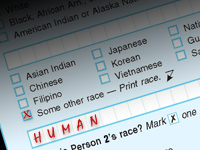Multiracial Identity [Film Review by Patricia B. McGee]Posted in Articles, Book/Video Reviews, Media Archive, Social Science, United States on 2012-03-12 21:11Z by Steven |
Multiracial Identity [Film Review by Patricia B. McGee]
Educational Media Reviews Online
2011-07-19
Patricia B. McGee, Coordinator of Media Services
Volpe Library & Media Center
Tennessee Technological University, Cookeville, Tennessee
Multiracial Identity
2010
Distributed by Bullfrog Films, PO Box 149, Oley, PA 19547; 800-543-FROG (3764)
Produced and Directed by Brian Chinhema
DVD, color, 77 min. and 56 min.
Jr. High – General Adult
African American Studies, Anthropology, Multicultural Studies, Sociology
![]() Highly Recommended
Highly Recommended
Multiracial Identity explores the complexities of what it means to be a person of mixed race heritage in the United States, and how the concept of mixed race “challenges racial perceptions and boundaries.” Race is a concept with its origins in custom and mores; in America persons with both black and white ancestry are viewed as black, a legacy of the ‘one drop rule’ intended to preserve the racial purity of the white race. The film explores the history of how multiracial individuals have been treated in America, how the mixed race class provided a shield between blacks and whites, and how the paper bag, blue vein or comb tests would be used to determine racial membership…
…For multiracial people the lack of a mixed race categorization can be a source of conflict and distress. Many find the categorization “other” on many forms to be dehumanizing, or they feel they “don’t really have a place.” Others, when forced to choose membership in a single group, feel they are denying half their heritage. Sometimes they end up without the strong support of the very cultural group they are forced to identify with. Yet, if the concept of race were eliminated, America would no longer be able to track racial discrimination. Muddying the water still further is the question where to place Hispanics—which is a linguistic rather than a racial group…
Read the entire review here.
